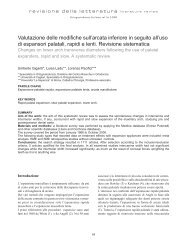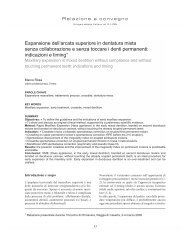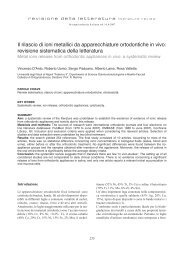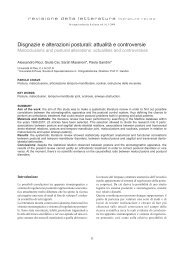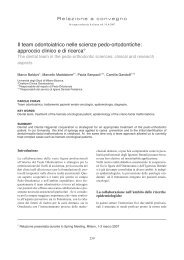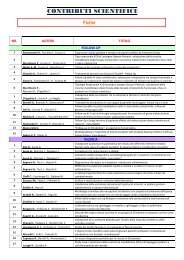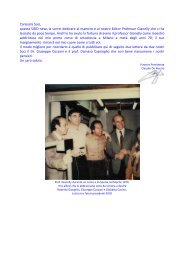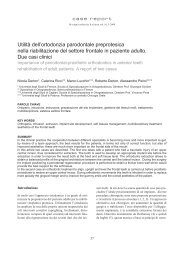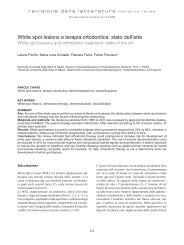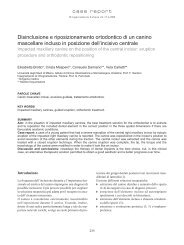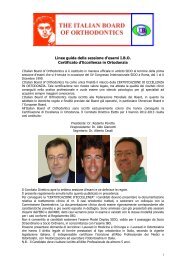Esperienze cliniche con apparecchiature self-ligating: quale futuro?°
Esperienze cliniche con apparecchiature self-ligating: quale futuro?°
Esperienze cliniche con apparecchiature self-ligating: quale futuro?°
You also want an ePaper? Increase the reach of your titles
YUMPU automatically turns print PDFs into web optimized ePapers that Google loves.
a permettere il movimento dentario o, al <strong>con</strong>trario, forze<br />
troppo pesanti che lo blocchino. Nelle metodiche <strong>con</strong>venzionali,<br />
invece, il clinico non è in grado di stabilire<br />
quanta della forza applicata verrà dissipata per vincere<br />
l’attrito e quanta realmente agirà sull’elemento dentario e<br />
quindi sul legamento parodontale. Applicando una forza<br />
leggera non si ottiene il movimento dentale in quanto tutta<br />
questa viene persa per vincere la frizione; applicando<br />
forze pesanti si rischia di ottenere un riassorbimento sottominante<br />
<strong>con</strong> ialinizzazione del legamento ed interruzione<br />
del movimento dentale.<br />
L’apparecchiatura <strong>self</strong>-<strong>ligating</strong> permette quindi al clinico<br />
di gestire le forze più semplicemente e i nuovi archi permettono<br />
al clinico l’utilizzo di forze leggerissime e biologicamente<br />
compatibili.<br />
Le forze leggere e biologiche che offrono questi archi<br />
agis<strong>con</strong>o in sinergia anche <strong>con</strong> le forze funzionali muscolari<br />
e dei tessuti molli: durante l’allineamento, infatti, le<br />
componenti neuro-muscolari di lingua e labbra stimolano<br />
gli elementi dentari a raggiungere la linea di minor resi-<br />
Relazione a <strong>con</strong>vegno<br />
Ortognatodonzia Italiana vol. 14, 1-2007<br />
33<br />
stenza. Al <strong>con</strong>trario, <strong>con</strong> le meccaniche ortodontiche tradizionali<br />
non si ottiene questo risultato in quanto le forze<br />
pesanti usate escludono dal <strong>con</strong>trollo della posizione<br />
dentale le strutture muscolari: una volta completato il<br />
trattamento le forze funzionali non saranno bilanciate e<br />
tenderanno a ricreare il quadro disgnatico.<br />
L’introduzione delle <strong>apparecchiature</strong> <strong>self</strong>-<strong>ligating</strong> è stata<br />
inoltre accompagnata dall’introduzione di nuove prescrizioni.<br />
Nelle tabelle 2 e 3 la prescrizione straight-wire<br />
standard (Andrews) viene <strong>con</strong>frontata <strong>con</strong> le prescrizione<br />
delle più recenti <strong>apparecchiature</strong> <strong>self</strong>-<strong>ligating</strong>.<br />
L’espansione di arcata così importante che si ottiene <strong>con</strong><br />
queste nuove <strong>apparecchiature</strong> non è dovuta solo alle loro<br />
caratteristiche biomeccaniche ma è anche in funzione<br />
delle nuove prescrizioni. In particolare le modifiche di<br />
torque e di tip introdotte <strong>con</strong> i nuovi sistemi <strong>self</strong>-<strong>ligating</strong><br />
permettono di recuperare spazio in arcata. Per esempio<br />
Damon utilizza per i canini superiori valori di 6<strong>°</strong> di tip e<br />
0<strong>°</strong> di torque rispetto ai valori di 11<strong>°</strong> di tip e -7<strong>°</strong> di torque<br />
della prescrizione standard. Con la prescrizione Damon il<br />
ANDREWS ROTH MBT DAMON<br />
Tip Torque Tip Torque Tip Torque Tip Torque<br />
centrale +5<strong>°</strong> +7<strong>°</strong> +5<strong>°</strong> +12<strong>°</strong> +4<strong>°</strong> +17<strong>°</strong> +5<strong>°</strong> +12<strong>°</strong><br />
laterale +9<strong>°</strong> +3<strong>°</strong> +9<strong>°</strong> +8<strong>°</strong> +8<strong>°</strong> +10<strong>°</strong> +9<strong>°</strong> +8<strong>°</strong><br />
canino +11<strong>°</strong> -7<strong>°</strong> +13<strong>°</strong> -2<strong>°</strong> +8<strong>°</strong> -7<strong>°</strong> +6<strong>°</strong> 0<strong>°</strong><br />
1 premolare +2<strong>°</strong> -7<strong>°</strong> 0<strong>°</strong> -7<strong>°</strong> 0<strong>°</strong> -7<strong>°</strong> +2<strong>°</strong> -7<strong>°</strong><br />
2 premolare +2<strong>°</strong> -7<strong>°</strong> 0<strong>°</strong> -7<strong>°</strong> 0<strong>°</strong> -7<strong>°</strong> +2<strong>°</strong> -7<strong>°</strong><br />
1 molare +5<strong>°</strong> -9<strong>°</strong> 0<strong>°</strong> -14<strong>°</strong> +10<strong>°</strong> -14<strong>°</strong> 0<strong>°</strong> -9<strong>°</strong><br />
2 molare +5<strong>°</strong> -9<strong>°</strong> 0<strong>°</strong> -14<strong>°</strong> +10<strong>°</strong> -14<strong>°</strong> 0<strong>°</strong> -9<strong>°</strong><br />
Tab. 2. Prescrizioni delle diverse <strong>apparecchiature</strong> <strong>self</strong>-<strong>ligating</strong> per l’arcata superiore.<br />
ANDREWS ROTH MBT DAMON<br />
Tip Torque Tip Torque Tip Torque Tip Torque<br />
centrale +2<strong>°</strong> -1<strong>°</strong> +2<strong>°</strong> -1<strong>°</strong> 0<strong>°</strong> -6<strong>°</strong> +2<strong>°</strong> -1<strong>°</strong><br />
laterale +2<strong>°</strong> -1<strong>°</strong> +2<strong>°</strong> -1<strong>°</strong> 0<strong>°</strong> -6<strong>°</strong> +2<strong>°</strong> -1<strong>°</strong><br />
canino +5<strong>°</strong> -11<strong>°</strong> +7<strong>°</strong> -11<strong>°</strong> +3<strong>°</strong> -6<strong>°</strong> +5<strong>°</strong> 0<strong>°</strong><br />
1 premolare +2<strong>°</strong> -17<strong>°</strong> -1<strong>°</strong> -17<strong>°</strong> +2<strong>°</strong> -12<strong>°</strong> +2<strong>°</strong> -12<strong>°</strong><br />
2 premolare +2<strong>°</strong> -22<strong>°</strong> -1<strong>°</strong> -22<strong>°</strong> +2<strong>°</strong> -17<strong>°</strong> +2<strong>°</strong> -17<strong>°</strong><br />
1 molare +2<strong>°</strong> -30<strong>°</strong> -1<strong>°</strong> -30<strong>°</strong> 0<strong>°</strong> -20<strong>°</strong> +2<strong>°</strong> -30<strong>°</strong><br />
2 molare +2<strong>°</strong> -35<strong>°</strong> -1<strong>°</strong> -30<strong>°</strong> 0<strong>°</strong> -10<strong>°</strong> 0<strong>°</strong> -10<strong>°</strong><br />
Tab. 2. Prescrizioni delle diverse <strong>apparecchiature</strong> <strong>self</strong>-<strong>ligating</strong> per l’arcata inferiore.



